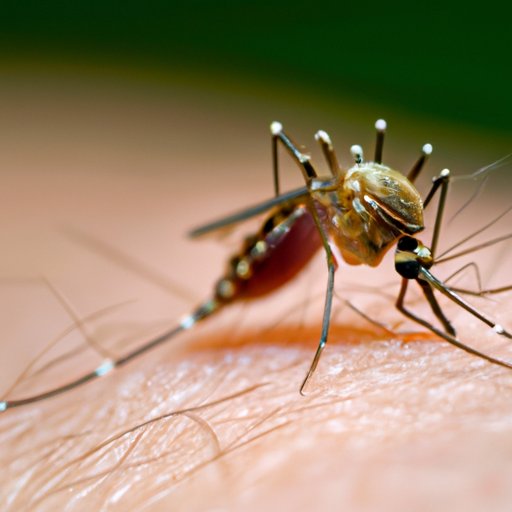
I. Introduction
Malaria is a serious and often fatal disease caused by a parasite. It is one of the world’s most notorious diseases, affecting millions of people worldwide, particularly in developing countries. The purpose of this article is to provide an overview of malaria, including its causes, symptoms, prevention, and treatment.
We will explore the parasitic infection by Plasmodium, the different types of the disease that can cause harm, and how it is transmitted by mosquitoes. In addition, we will discuss progress in controlling malaria, the challenges currently faced by the global health community, and future approaches in prevention.
II. Understanding the Cause: Exploring the Mosquito-Borne Parasite That Causes Malaria
Malaria is caused by the Plasmodium parasite, which is carried by infected mosquitoes. The parasite travels to the liver, where it multiplies before infecting red blood cells.
There are different types of Plasmodium, and some are more dangerous than others. For example, Plasmodium falciparum is responsible for the majority of malaria cases and deaths worldwide; it causes severe and potentially fatal symptoms. Plasmodium vivax is less deadly, but still causes illness and can create significant health complications if left untreated.
The parasite has a complex life cycle that involves both mosquitoes and humans. After a mosquito bites an infected person, the parasites develop within the mosquito. When the mosquito bites another person, it injects the parasites, which can then enter the bloodstream and start multiplying.
III. Avoiding The Bite: How to Protect Yourself Against Mosquitoes and Malaria
Since malaria is spread by mosquitoes, avoiding mosquito bites is the first line of defense against its transmission. One effective approach is by using mosquito repellent, which can reduce the risk of getting bitten. Additionally, wearing long-sleeved shirts, long pants, and avoiding outdoor activities during prime mosquito-active times, such as dawn and dusk, can minimize bites.
Another way to prevent malaria is by sleeping under bed nets, which act as a barrier between people and mosquitoes. Indoor residual spraying is another effective method that can reduce the number of infected mosquitoes in a household. Proper education about prevention and hygiene plays an essential role in preventing malaria transmission in communities.
IV. The Fight Against Malaria: Progress and Challenges Facing the Global Health Community
The fight against malaria has been long and arduous. It has taken many global strategic efforts to achieve promising results in reducing cases and deaths related to malaria, but new challenges pose threats to the long-term sustainable efforts against malaria.
The World Health Organization (WHO) has a goal to reduce malaria cases and deaths by 90% by 2030. The WHO’s Global Technical Strategy for Malaria 2016-2030 has set a framework to help countries move towards this goal.
Despite these efforts, malaria still poses a significant threat to public health worldwide. Drug resistance and limited funding threaten progress, making it more difficult to control malaria and putting millions of people at risk.
V. Malaria in Context: Examining the Link Between Poverty, Climate Change & Infectious Disease
Malaria has strong interlinkages with poverty and environmental factors such as climate change. People living in poverty are at higher risk of contracting malaria due to poor living conditions and inadequate healthcare access.
Climate change and global warming affect ecosystems and expand the geographic range of mosquitos, allowing them to carry diseases like malaria to new areas. It is essential to understand how the relationship between environmental and socioeconomic factors affects the spread of malaria, especially in some of the hardest-hit regions of the world.
VI. Diagnosis & Treatment: What to Know About Malaria Symptoms and Healthcare Providers
The symptoms of malaria vary from mild to severe, depending on factors such as the type of Plasmodium, the person’s immunity, and the level of care available.
The symptoms may include fever and chills, headache, body aches, nausea, and vomiting. In severe cases, it can lead to breathing difficulties, organ failure, and even death. Early treatment is critical. If you experience symptoms or have been to areas with malaria cases, you must see a doctor immediately.
Treatment for malaria depends on the type of parasite. Antimalarial drugs are used for treating the illness, which work to clear parasites from the bloodstream. Supportive therapy, such as blood transfusions, can alleviate severe symptoms.
VII. The Future of Malaria Prevention: Promising Research and Innovations in Public Health
Malaria prevention research and innovation have created promising advancements towards preventing and eliminating malaria. One outstanding example is the ongoing development of a malaria vaccine, reaching the final stages of clinical trials in several regions in the world.
Gene editing also holds promise as it can help transform the mosquito population into one that is less prone to carrying Plasmodium. Community engagement and improved surveillance, facilitated by digital health technology, are showing potential in identifying outbreaks and delivering vital healthcare resources.
VIII. Conclusion
In conclusion, malaria is a disease that affects millions of people worldwide and demands our attention and intervention. Although progress has been made in the fight against malaria, there is still a long way to go.
A combination of efforts, including effective prevention measures, access to proper healthcare, and research and innovation to create new interventions and control methods, is crucial. We must work together to prevent and control this disease, and ultimately, to eliminate it.
Be sure to get involved in malaria prevention and control efforts, whether through education, volunteering, or supporting public health initiatives. By working together, we can make the world a malaria-free place.





